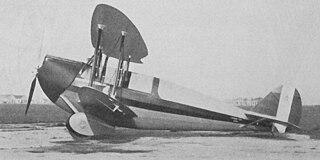Related Research Articles

The Caproni Ca.37 was a ground attack aircraft designed and built in Italy by Caproni around 1916

The Caproni Ca.90 was a prototype Italian heavy bomber designed and built by Caproni. When it first flew in 1929 it was the largest land-based aircraft in the world.

The Caproni Ca.125 was a single-engine, tandem two-seat, touring biplane built in Italy in 1933. It could be operated either as a landplane or seaplane.
The Caproni Ca.61 was an Italian heavy day bomber aircraft of 1922. It was the final development of the Caproni three engine, twin boom biplane types developed during World War I, but it was not put into production.
The Caproni Ca.66 was an Italian night bomber designed to reequip the post-World War I Italian Air Force. Only two examples of the four-engined biplane were built.
The Caproni Ca.134 was a biplane reconnaissance aircraft built by the Italian company Caproni in the 1930s.

The Caproni Ca.16 was a single-engine monoplane designed and built by Caproni in the early 1910s.
The Caproni Ca.10 was a single-engine monoplane designed and built by Caproni in the early 1910s.

The Caproni Ca.9 was a single-engine monoplane designed and built by Caproni in the early 1910s.

The Caproni Ca.6 was a single-engine biplane designed and built by Caproni in the early 1910s.

The Caproni Ca.8 was a single-seat monoplane designed and built by Caproni in the early 1910s.

The Caproni Ca.22 was a single-engine monoplane made by the Italian company Aeronautica Caproni in 1913.
The Caproni Ca.66 and Caproni Ca.67 were Italian night bomber aircraft designed to re-equip the post-World War I Regia Aeronautica.
The Caproni Ca.72 was an Italian night bomber designed to reequip the post-World War I Italian Air Force.
The Caproni Ca.79 was an Italian light bomber produced in the mid-1920s.

The Caproni Ca.105 was a multirole high wing single engine monoplane developed by the Italian aeronautical company Aeronautica Caproni in the late 1920s.
The Caproni Ca.120 was a three-engine monoplane bomber built by Caproni in the 1930s.
The Caproni Ca.127 was a single-engine reconnaissance monoplane built by Caproni in the mid-1930s.
The Caproni Ca.142 was a three-engined multirole aircraft built by Caproni in the mid-1930s.

The Caproni Ca.53 was an Italian prototype light bomber built in the last months of World War I.
References
- ↑ "Canponi Ca.103". Airwar.ru. Retrieved 2019-02-03.
- ↑ Caproni, Gianni (1937). Aeroplani Caproni dal 1908 al 1935 (in Italian). Milan: Edizioni d'arte Emilio Bestetti. p. 298.